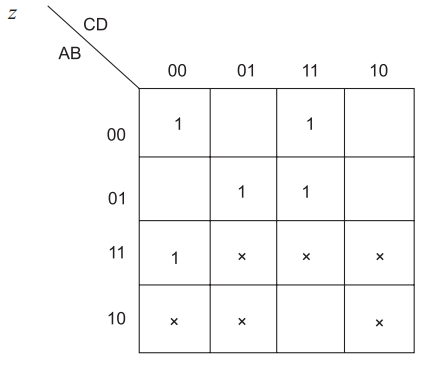| Decimal |
BCD(5421) |
BCD(8421) |
|
A |
B |
C |
D |
W |
X |
Y |
Z |
| 0 |
0 |
0 |
0 |
0 |
0 |
0 |
0 |
0 |
| 1 |
0 |
0 |
0 |
1 |
0 |
0 |
0 |
1 |
| 2 |
0 |
0 |
1 |
0 |
0 |
0 |
1 |
0 |
| 3 |
0 |
0 |
1 |
1 |
0 |
0 |
1 |
1 |
| 4 |
0 |
1 |
0 |
0 |
0 |
1 |
0 |
0 |
| 5 |
1 |
0 |
0 |
0 |
0 |
1 |
0 |
1 |
| 6 |
1 |
0 |
0 |
1 |
0 |
1 |
1 |
0 |
| 7 |
1 |
0 |
1 |
0 |
0 |
1 |
1 |
1 |
| 7 |
1 |
0 |
1 |
0 |
0 |
1 |
1 |
1 |
| 8 |
1 |
0 |
1 |
1 |
1 |
0 |
0 |
0 |
| 9 |
1 |
1 |
0 |
0 |
1 |
0 |
0 |
1 |
W = ∑m(11, 12) + ∑d(5, 6, 7, 13, 14, 15)
X = ∑m(4, 8, 9, 10) + ∑d(5, 6, 7, 13, 14, 15)
Y = ∑m(2, 3, 9, 10) + ∑d(5, 6, 7, 13, 14, 15)
Z = ∑m(1, 3, 8, 10, 12) + ∑d(5, 6, 7, 13, 14, 15)
(b) W = AB + ACD
X=\bar{A} B+A \bar{B} \bar{C}+A \bar{B} \bar{D}
or
\bar{A} B+A \bar{B} \bar{C}+A C \bar{D}
or
\begin{aligned}&\bar{A} B+A \bar{C} D+A \bar{B} \bar{D} \\&Y=\bar{A} C+A \bar{C} D+C \bar{D} \\&Z=\bar{A} D+A \bar{D}\end{aligned}
(a)
| Decimal |
BCD(5421) |
BCD(8421) |
|
A |
B |
C |
D |
W |
X |
Y |
Z |
| 0 |
0 |
0 |
0 |
0 |
0 |
0 |
0 |
0 |
| 1 |
0 |
0 |
0 |
1 |
0 |
0 |
0 |
1 |
| 2 |
0 |
0 |
1 |
0 |
0 |
0 |
1 |
0 |
| 3 |
0 |
0 |
1 |
1 |
0 |
0 |
1 |
1 |
| 4 |
0 |
1 |
0 |
0 |
0 |
1 |
0 |
0 |
| 5 |
0 |
1 |
0 |
1 |
0 |
1 |
0 |
1 |
| 6 |
0 |
1 |
1 |
0 |
0 |
1 |
1 |
0 |
| 7 |
0 |
1 |
1 |
1 |
0 |
1 |
1 |
1 |
| 8 |
1 |
0 |
1 |
1 |
1 |
0 |
0 |
0 |
| 9 |
1 |
1 |
0 |
0 |
1 |
0 |
0 |
1 |
W = ∑m(11, 12) + ∑d(8, 9, 10, 13, 14, 15)
X = ∑m(4, 5, 6, 7) + ∑d(8, 9, 10, 13, 14, 15)
Y = ∑m(2, 3, 6, 7) + ∑d(8, 9, 10, 13, 14, 15)
Z = ∑m(1, 3, 5, 7, 12) + ∑d(8, 9, 10, 13, 14, 15)
\begin{aligned}&W=A \\&X=\bar{A} B \\&Y=\bar{A} C \\&Z=A B+B D+\bar{A} C D+\bar{B} \bar{C} \bar{D}\end{aligned}
Hence, the correct option is (a).








